Summary Table 2 Social Benefit Balance Table, FY2012 (No. 1)
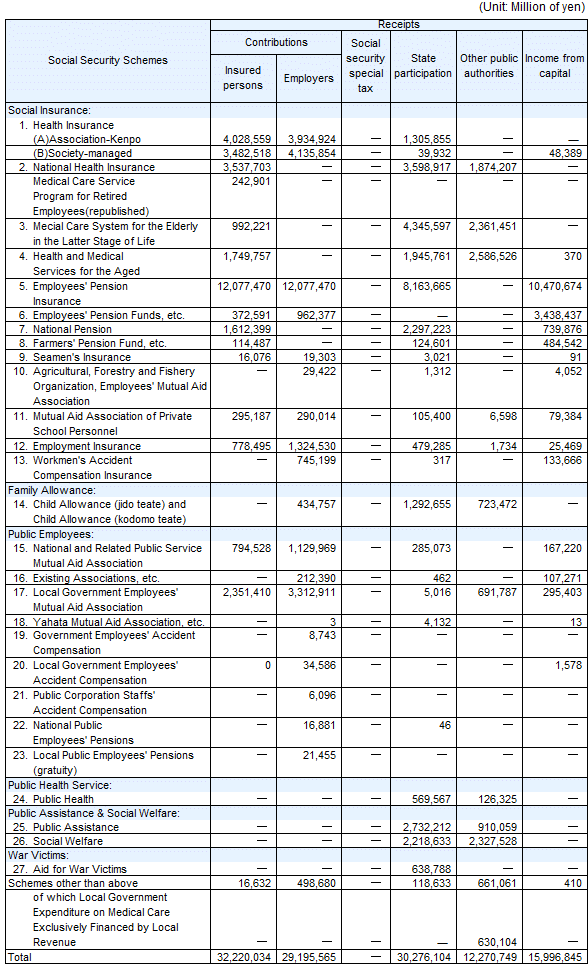
Summary Table 2 continued (No. 2)
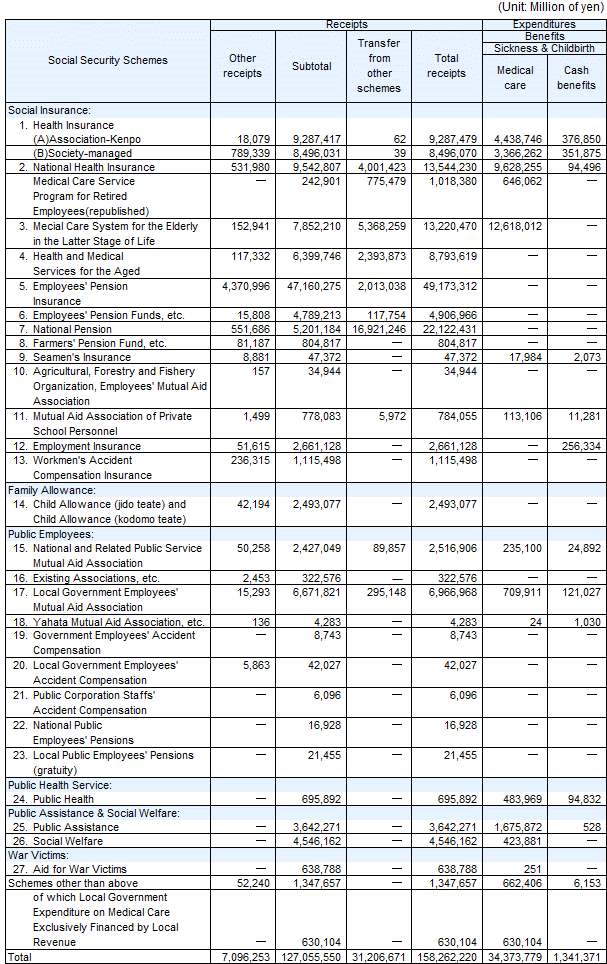
Summary Table 2 continued (No. 3)
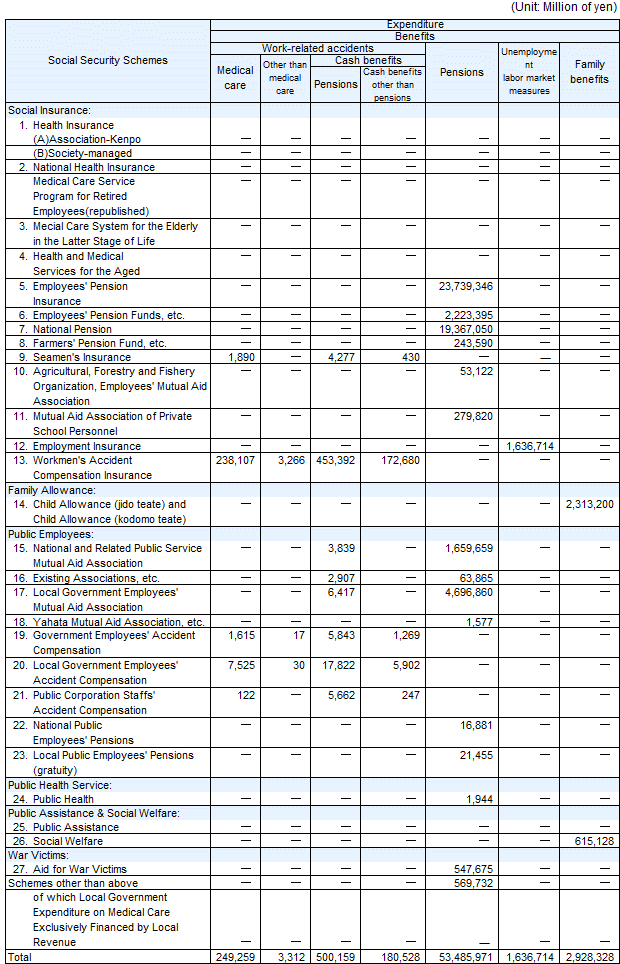
Summary Table 2 continued (No. 4)
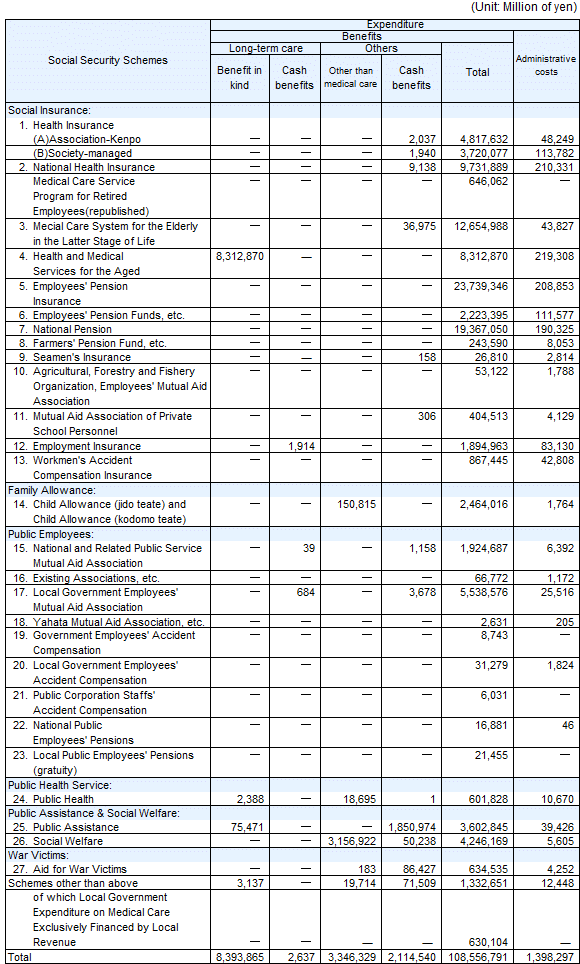
Summary Table 2 continued (No. 5)
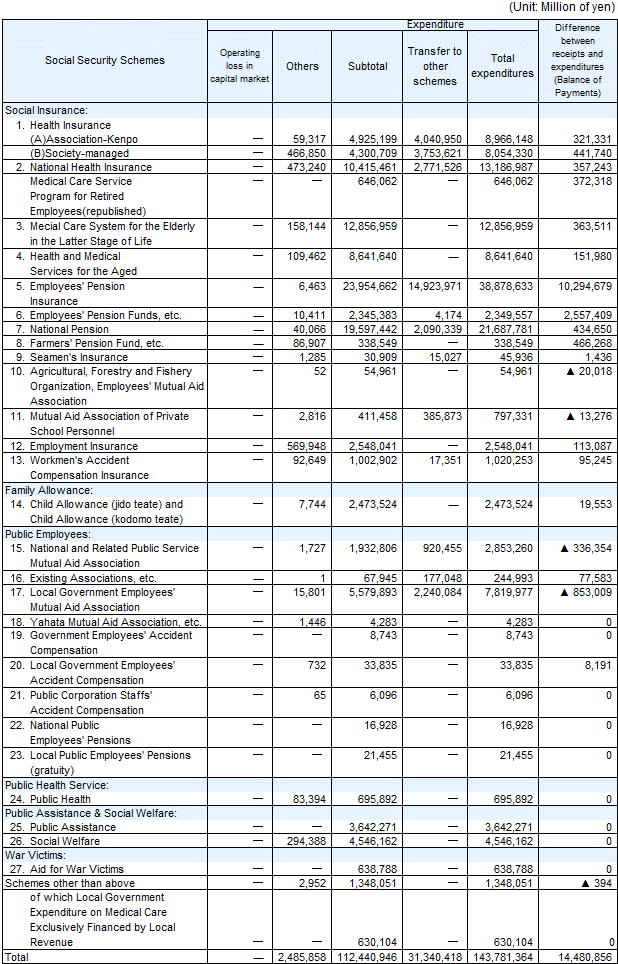
|
Notes:
|
1.
|
Summary Table 2 is calculated in accordance with the standard of the ILO's "The Cost of Social Security 18th International Inquiry". The estimates were made through the annual settlement of each scheme's accounts for fiscal year 2012.
|
|
|
2.
|
“National Pension” includes the welfare pension and the universal basic pensions.
|
|
|
3.
|
The revenue from capital of the Employee’s Pension Insurance and the National Pension is estimated with reference to the Annual Report of Capital Gain of Pensions' Funds for fiscal year 2012. The estimated sum includes an inherited gain and loss from the previous scheme.
|
|
|
4.
|
“Employees’ Pension Fund, etc.” includes the Load Mining Pension Fund. The amount of pension includes a portion paid by the employee’s pension fund in lieu of the state.
|
|
|
5.
|
“Farmers’ Pension Fund, etc.” includes the National
Pension Fund.
|
|
|
6.
|
“Agricultural, Forestry and Fishery Organization,
Employees’ Mutual Aid Association” was amalgamated into Employees’
Pension Insurance on April 1, 2002; however, the third tier
of the original pension scheme remained in the former organization.
|
|
|
7.
|
“Public health” includes public grants for the
treatment of tuberculosis, etc.
|
|
|
8.
|
“Family benefits” include not only child allowances
but also income support for single parent families and handicapped
children.
|
|
|
9.
|
As of April 1997, short-term benefits (i.e.,
medical benefits) of “Public Corporations Staff Mutual Aid Associations” have been transferred to society-managed health insurance, and
long-term benefits (i.e., pension benefits) have been integrated
into employees’ pensions. Further, part of the pension benefits
have also been transferred to “16. Existing Associations,
etc.”
|
|
|
10.
|
Other schemes include Relief System for Sufferers from Adverse Drug Reactions, Relief System for Sufferers from Diseases Infected from Biological Products, Small-and-medium Size Enterprise Retirement Allowance Mutual Aid System, Mutual Aid System for the Retirement Allowance for the Staff of Social Welfare Institutions etc., Pollution-related Health Damage Compensation System, Asbestos Health Damage Relief System, Japan Sport Council Mutual Aid Benefit, School Expense Assistance Programme, Support for Those Suffering from Residual Disability from Automobile Accident, Public Housing Rent Subsidy, Benefit System for Crime Victims, Disaster Victims Livelihood Recovery Support System, and Local Government Expenditure on Medical Care Exclusively Financed by Local Revenue. Refer to Table 15 (on the HP) in the Appendix No.6 for the amounts of receipts and expenditure of each system.
|
|
|
11.
|
“Unemployment and labor market measures” include subsidies for elderly employees.
|
| |
12.
|
The Category I insured persons’ contributions to the long-term care insurance are included in the “Contributions” of the long-term care insurance. The Category II insured persons’ contributions are included in the “Contributions” of the health insurance, etc., which will then be recorded in the form of transfer to the long-term care insurance (“Transfer to other schemes” and the long-term care insurance’s “Transfer from other schemes” within the health insurance etc.). |
| |
13.
|
Among the sources of revenue of the “Mecial Care System for the Elderly in the Latter Stage of Life”, support coverage of the “Mecial Care System for the Elderly in the Latter Stage of Life” is recorded as the “Transfer to other systems” of the health insurance etc., and its receipt is included as a part of the “Transfer from other schemes” of the “Mecial Care System for the Elderly in the Latter Stage of Life”. |
| |
14.
|
The Category II insured person’s contributions to the National Pension are collected along with their contributions to the Employee’s Pension Insurance, of which the portion for the Basic Pension is recorded in the form of transfer from the Employee’s Pension Insurance to the National Pension (The “Transfer to other schemes” of the Employee’s Pension Insurance and the “Transfer from other schemes” of the National Pension). |
| |
15.
|
Rounding of the numbers may cause some discrepancies. After the rounding of numbers, a zero represents up to one million. |
|
|
|
|
| |
|
Explanatory notes on items from “Social Benefit”
|
1. |
Explanatory notes on receipts items |
|
The “Social Security Revenue” in this publication refers to the “Subtotal” of the revenue, which excludes the “Transfer from other systems.”
|
|
(i) |
Income from capital includes interest, dividends, rents, capital gains, profits from redemption, etc.
|
|
(ii) |
Other receipts include receipts from reserve, etc.
|
|
(iii) |
Transfers from other schemes include the following: contributions to special schemes for persons employed on a daily-wage basis in Association-Kenpo Health Insurance and National Health Insurance; transfer payments from all health insurance schemes to the Medical Care Service Program for Retired Employees in National Health Insurance; transfer payment from all schemes to the medical care system for early-stage elderly; transfer payments from all health insurance schemes to the medical care system for latter-stage elderly; transfer payments from all schemes to the National Pension for contribution to universal basic pensions; transfer payments from the National Pension to other schemes for the payment of universal Basic Pensions, transfer payments from all health insurance schemes to Long-term care insurance, etc.
|
2. |
Explanatory notes on expenditure items
|
|
The “Social Security Expenditure” in this publication refers to “Benefits – total” of the expenditure, excluding the “Administrative costs,” “Operating loss,” “Other” and “Transfer to other schemes.”
|
|
|
(i)
|
Administrative costs include business handling expenses, general affairs expenses, office expenses, operation expenses for the Japan Pension Service, and etc.
|
|
(ii)
|
Operating losses include loss on valuation of the reserve funds at the time of account settlement.
|
| |
(iii)
|
Other expenditures include maintenance fees for the facilities, etc.
|
|
|
(iv)
|
Transfers to other schemes include transfer payments from the other health insurance schemes to special schemes for persons employed on a daily-wage basis, for Retired Employees, for early-stage elderly and for Medical care system for latter-stage elderly; transfer payments from Other pension schemes to the National Pension for universal Basic Pensions; transfer payments paid by the National Pension to the other schemes for the universal Basic Pension, transfer payments from all health insurance schemes to Long-term care contributions, etc.
|
3. |
Difference between receipts and expenditures
“ Difference between receipts and expenditures” refers to the difference between the “Revenue - Total revenue” and “Expenditure - Total expenditure.”
|
4. |
Correspondence with the categorical classification
The figures by category are calculated by re-aggregating figures in Summary Table 2. The category “Medical care” is the sum of the “Sickness and maternity - medical care” and “Employment injury” in this Table, while “Pension” is the sum of “Employment injury – pension” and “Pension,” and “Other welfare” is the sum of items other than those listed above in “benefits.”
|
|
Download the following >> |
Return to the Contents
Return to the top page of the Financial Statistics of Social Security in Japan

|